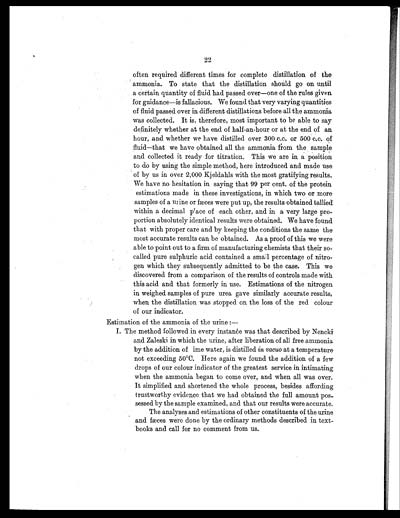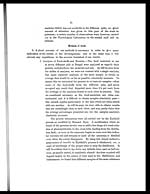Medicine - Institutions > Army health reports and medical documents > Scientific memoirs by officers of the Medical and Sanitary Departments of the Government of India > Number 37 - Investigations on Bengal jail dietaries > Front matter
(32) Page 22
Download files
Individual page:
Thumbnail gallery: Grid view | List view

22
often required different times for complete distillation of the
ammonia. To state that the distillation should go on until
a certain quantity of fluid had passed over—one of the rules given
for guidance—is fallacious. We found that very varying quantities
of fluid passed over in different distillations before all the ammonia
was collected. It is, therefore, most important to be able to say
definitely whether at the end of half-an-hour or at the end of an
hour, and whether we have distilled over 300 c.c. or 500 c.c. of
fluid—that we have obtained all the ammonia from the sample
and collected it ready for titration. This we are in a position
to do by using the simple method, here introduced and made use
of by us in over 2,000 Kjeldahls with the most gratifying results.
We have no hesitation in saying that 99 per cent. of the protein
estimations made in these investigations, in which two or more
samples of a urine or fæces were put up, the results obtained tallied
within a decimal place of each other, and in a very large pro-
portion absolutely identical results were obtained. We have found
that with proper care and by keeping the conditions the same the
most accurate results can be obtained. As a proof of this we were
able to point out to a firm of manufacturing chemists that their so-
called pure sulphuric acid contained a small percentage of nitro-
gen which they subsequently admitted to be the case. This we
discovered from a comparison of the results of controls made with
this acid and that formerly in use. Estimations of the nitrogen,
in weighed samples of pure urea gave similarly accurate results,
when the distillation was stopped on the loss of the red colour
of our indicator.
Estimation of the ammonia of the urine:—
I. The method followed in every instance was that described by Nencki
and Zaleski in which the urine, after liberation of all free ammonia
by the addition of ime water, is distilled in vacuo at a temperature
not exceeding 50°C. Here again we found the addition of a few
drops of our colour indicator of the greatest service in intimating
when the ammonia began to come over, and when all was over.
It simplified and shortened the whole process, besides affording
trustworthy evidence that we had obtained the full amount pos-
sessed by the sample examined, and that our results were accurate.
The analyses and estimations of other constituents of the urine
and fæces were done by the ordinary methods described in text-
books and call for no comment from us.
Set display mode to: Large image | Zoom image | Transcription
Images and transcriptions on this page, including medium image downloads, may be used under the Creative Commons Attribution 4.0 International Licence unless otherwise stated. ![]()
| Permanent URL | https://digital.nls.uk/75032811 |
|---|




